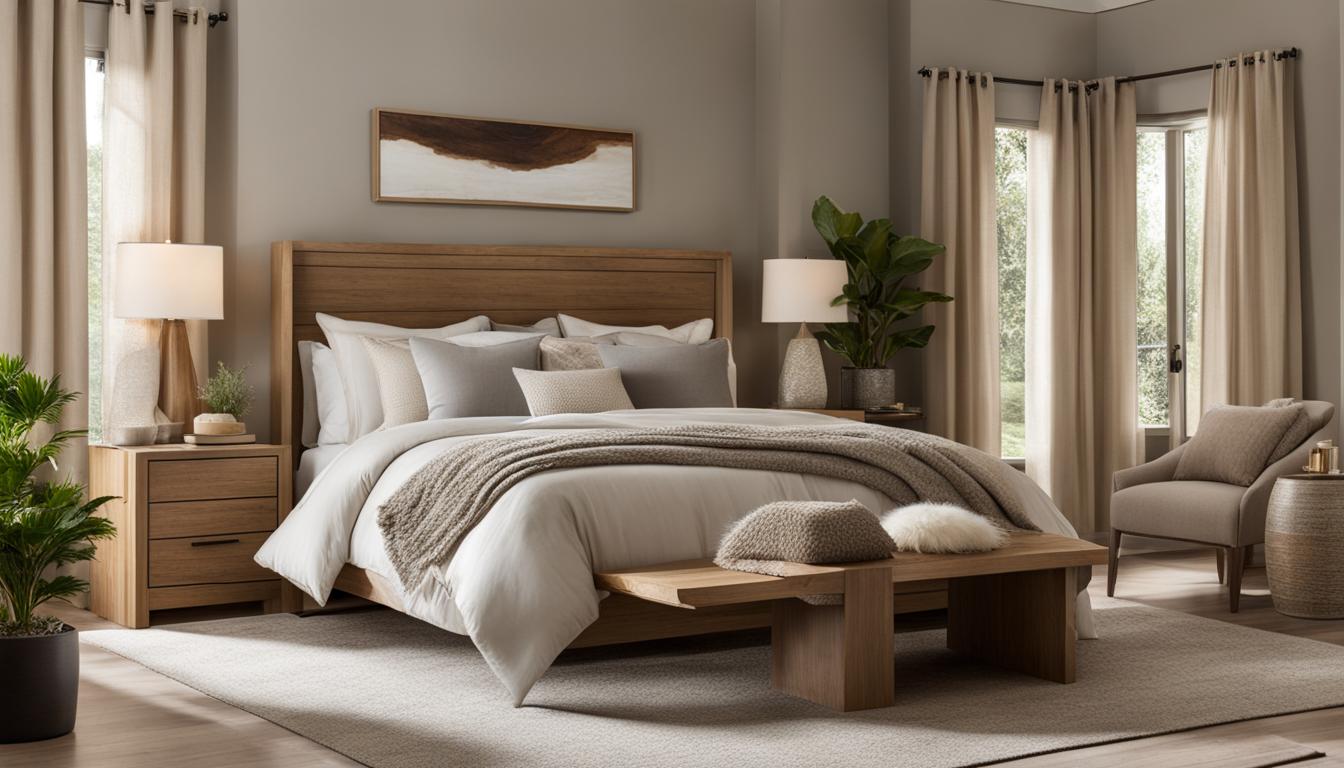Are you struggling to get a good night’s sleep? The answer could be in the colors you choose for your bedroom. When it comes to creating a peaceful and nurturing sleep environment, Feng Shui principles offer valuable guidance.
By understanding the psychology behind color choices and the impact they have on our mood and energy levels, we can create a space that promotes restful sleep and rejuvenation. In this article, we’ll explore some of the best bedroom color ideas Feng Shui has to offer, and how they can help you unlock peaceful sleep.
Key Takeaways:
- Feng Shui principles can guide us in creating a peaceful sleep environment.
- Choosing the right colors for our bedroom can enhance sleep quality and overall well-being.
- Understanding the psychology behind color choices can help us create a space that promotes restful sleep and rejuvenation.
- In this article, we’ll explore the best bedroom color ideas Feng Shui has to offer, as well as practical tips for incorporating them into your decor.
- By combining the knowledge gained from this article, you can create a harmonious sleep sanctuary that promotes restful and rejuvenating sleep.
Understanding Feng Shui Bedroom Color Schemes
If you’re looking to create a peaceful and harmonious bedroom, understanding the principles of Feng Shui and how they relate to color is essential. Feng Shui is an ancient Chinese practice that focuses on creating a balanced and positive flow of energy, or Qi, in a particular space. When it comes to the bedroom, the right color scheme can promote relaxation and improve sleep quality. Read on to learn about the different Feng Shui bedroom color schemes and their specific meanings.
Brief Overview of Feng Shui Principles
Before delving into specific color schemes, it’s important to have a basic understanding of Feng Shui principles. According to Feng Shui, every aspect of our environment, including the colors we choose, can have an impact on our well-being and energy levels. The colors we surround ourselves with can affect our mood, emotions, and even our physical health. Therefore, when selecting colors for your bedroom, it’s important to choose those that align with your personal energy and promote harmony and balance.
The Five Elements of Feng Shui
In Feng Shui, colors are often associated with the five elements: Wood, Fire, Earth, Metal, and Water. Each element is represented by specific colors and has its own unique qualities and energy. For example, Wood is associated with growth and renewal, and its colors include green and brown. Fire is associated with passion and vitality and its colors include red, pink, and orange. Earth is associated with stability and nourishment and its colors include yellow and beige. Metal is associated with clarity and precision and its colors include white and gray. Lastly, Water is associated with ease and flow, and its colors include blue and black.
| Element | Colors |
|---|---|
| Wood | Green, Brown |
| Fire | Red, Pink, Orange |
| Earth | Yellow, Beige |
| Metal | White, Gray |
| Water | Blue, Black |
Color Schemes for Feng Shui Bedrooms
Now that you have a basic understanding of Feng Shui principles and the associated colors, here are some specific color schemes to consider for your bedroom:
- Wood and Earth: These colors promote calmness and stability. Consider using shades of brown and green to create a sense of grounding and relaxation.
- Fire and Earth: This color scheme is perfect if you want to add a little bit of passion and excitement to your space. Think warm shades of red or orange combined with earthy tones like beige or brown.
- Metal and Water: This color scheme promotes clarity and ease. Consider using shades of blue and gray to create a calming and tranquil environment.
- Monochromatic: If you prefer a more subtle approach, consider using different shades of the same color. For example, varying shades of blue can create a relaxing and peaceful atmosphere.
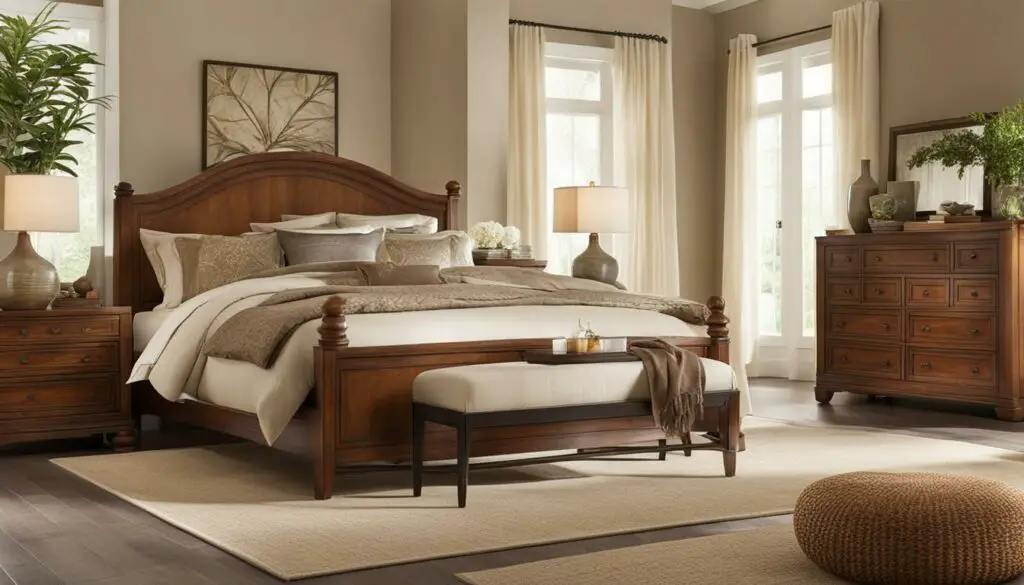
Remember, the key to creating a Feng Shui bedroom color scheme is to choose colors that align with your personal energy and create a harmonious and balanced environment. Use the table above and color schemes as a guide and experiment with different combinations to find what works best for you.
Best Feng Shui Colors for Bedrooms
If you’re looking to create a peaceful and harmonious environment in your bedroom, choosing the right colors is key. According to Feng Shui principles, certain colors can promote relaxation, restful sleep, and overall well-being. Here are some of the best Feng Shui colors for bedrooms:
| Color | Meaning | Effects |
|---|---|---|
| Blue | Calming, soothing | Reduces stress and anxiety, promotes relaxation |
| Green | Renewal, growth | Creates a sense of balance and harmony, promotes healing and renewal |
| Purple | Royalty, luxury | Creates a sense of tranquility and calm, promotes spiritual and emotional well-being |
| Pink | Love, nurturing | Creates a warm and loving atmosphere, promotes intimacy and connection |
| White | Purity, clarity | Creates a sense of spaciousness and clarity, promotes mental and emotional clarity |
| Gray | Neutral, calming | Creates a sense of calm and tranquility, promotes relaxation and restful sleep |
These colors can be incorporated into your bedroom decor in a variety of ways, from wall paint to bedding, furniture, and accents. Experiment with different shades and combinations to create a personalized and harmonious atmosphere that suits your unique style and needs.

Bedroom Color Psychology
Did you know that the colors you choose for your bedroom can have a significant impact on your mood and sleep patterns? The psychology of color has long been studied, and it’s no surprise that certain colors can evoke specific emotions and feelings.
Red is a vibrant color associated with passion and energy. However, it is not recommended for bedrooms as it can be too stimulating and interfere with sleep.
Blue is a calming color that promotes relaxation and tranquility. It is an excellent choice for bedrooms as it can help lower blood pressure and heart rate, leading to a better sleep quality.
Green is another soothing color that is associated with nature and harmony. It can bring a sense of balance and calmness to the bedroom, promoting restful sleep.
Purple is a regal and luxurious color that is often associated with creativity and spirituality. It can add a touch of sophistication to the bedroom, but it should be used in moderation as it can be too dark and overwhelming.
Yellow is a bright and cheerful color that can create a warm and welcoming atmosphere. However, it should be used in a muted tone as overly bright shades can be too energizing and disruptive to sleep.
Gray is a neutral color that can create a sense of calm and tranquility in the bedroom. It works well with other colors, making it a versatile choice for a peaceful sleep environment.
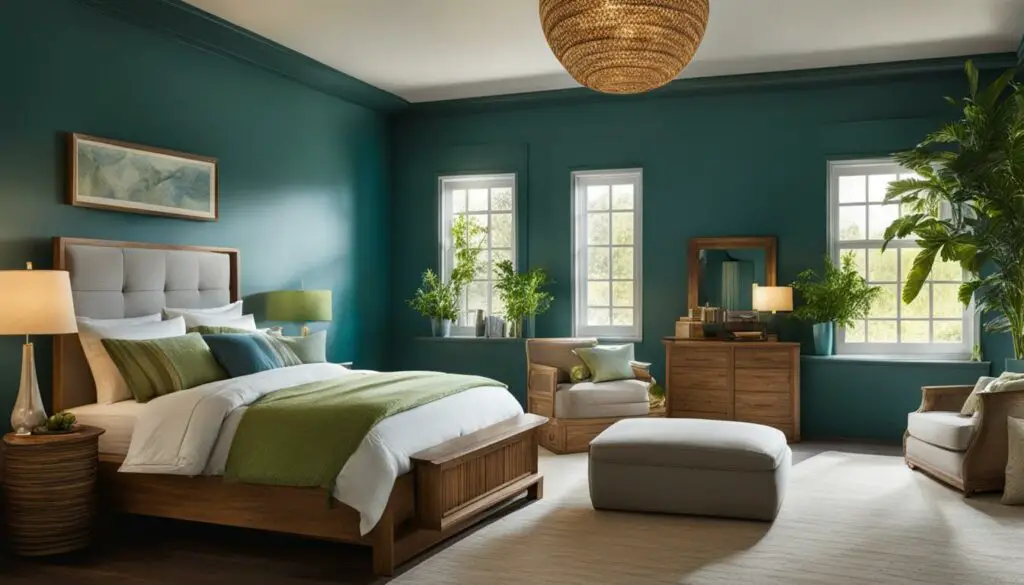
“Colors, like features, follow the changes of the emotions.”
– Pablo Picasso
Paint Colors for a Peaceful Bedroom
Choosing the right colors for your bedroom can transform it into a peaceful sanctuary where you can relax and unwind. Here are some paint color ideas that can create a soothing and tranquil atmosphere in your bedroom:
| Color | Description |
|---|---|
| Blue | One of the most popular bedroom colors, blue can evoke a sense of calmness and tranquility. Lighter shades of blue are especially peaceful and can help lower blood pressure and heart rate, promoting relaxation. |
| Green | Symbolizing growth and renewal, green can create a serene and tranquil environment. It is also associated with balance and harmony, making it an ideal color for creating a calm and relaxing atmosphere. |
| Pink | A soft and soothing color, pink can create a warm and nurturing environment. It is known for its calming effects and can help relieve stress and anxiety. |
| Purple | A luxurious color, purple can create a sense of indulgence and relaxation in the bedroom. It is also associated with spirituality and can enhance feelings of calmness and tranquility. |
When choosing a paint color for your bedroom, it’s essential to consider the amount of natural light your room receives. If your bedroom has limited natural light, lighter shades of paint can help create a brighter and more spacious feel. Darker colors, on the other hand, can make a room feel smaller and cozier.
Remember, the colors you choose for your bedroom should reflect your personal style and taste. Don’t be afraid to experiment with different shades and combinations until you find the perfect paint color for a peaceful and relaxing bedroom.

Calming Bedroom Color Palette
Creating a calming bedroom color palette is all about choosing hues that promote relaxation and tranquility. The right color scheme can help to reduce stress and anxiety, making it easier to unwind and fall asleep. When selecting colors for your bedroom, it’s important to keep in mind your personal preferences and how each color makes you feel. With that being said, there are a few colors that are universally recognized for their calming properties.
| Color | Properties | Examples |
|---|---|---|
| Blue | Calming, serene, and promotes feelings of peace and relaxation. | Sky blue, baby blue, powder blue |
| Green | Refreshing, soothing, and promotes feelings of calm and balance. | Sage green, pale green, mint green |
| Lavender | Relaxing, calming, and promotes restful sleep. | Lavender, lilac, periwinkle |
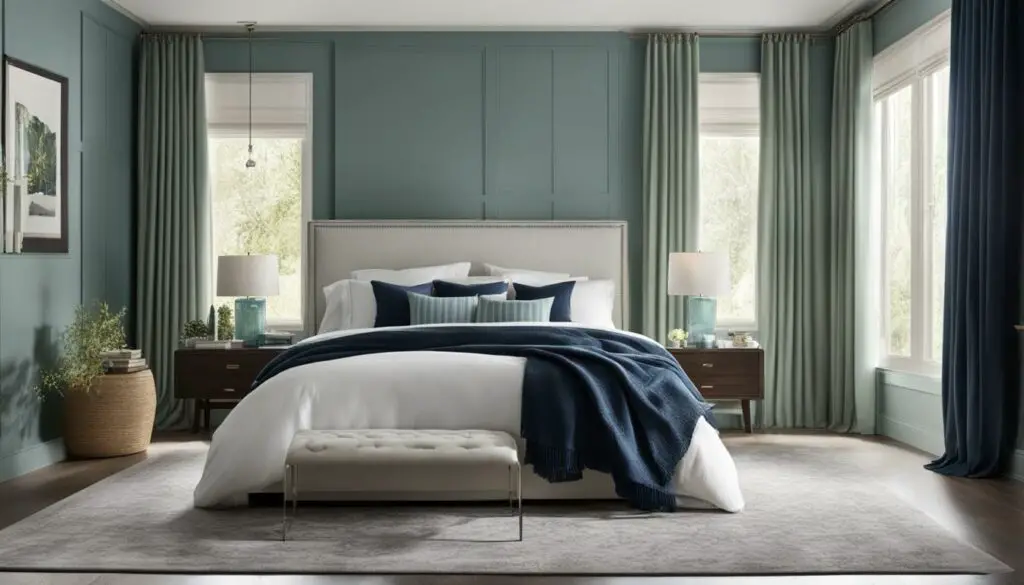
Neutral colors, such as beige, gray, and white, can also be used to create a calming atmosphere in the bedroom. These colors serve as a backdrop for more vibrant accents or work together to create a monochromatic color scheme. However, it’s important not to overuse neutral colors, as they can sometimes feel cold or sterile.
When creating a calming bedroom color palette, it’s important to think about the overall mood you want to create. Soft, muted, and pastel colors work well for a calming and peaceful atmosphere, while bold and bright colors should be used sparingly to avoid overstimulation.
Feng Shui Bedroom Colors for Love and Romance
According to Feng Shui principles, certain colors can enhance the energy of love and romance in your bedroom. Whether you’re looking to improve your relationship with your significant other or attract new love into your life, these colors may be worth considering.
| Color | Meaning |
|---|---|
| Red | A passionate and energetic color that symbolizes love, intimacy, and desire. |
| Pink | A softer, more romantic version of red that represents love, nurturing, and compassion. |
| White | A pure and innocent color that can create a peaceful and serene atmosphere, promoting intimacy and closeness. |
| Purple | A luxurious and sensual color that signifies passion, creativity, and spiritual connection. |
When using these colors in your bedroom, it’s important to keep in mind that balance is key. Too much of any color can have the opposite effect and create a disruptive or chaotic atmosphere. Consider using these colors in accents or decor rather than as the dominant color scheme.
Additionally, it’s important to note that Feng Shui principles prioritize the energy of the individual over any prescribed set of rules. Ultimately, the most important thing is to choose colors that make you feel happy, relaxed, and at ease in your space.
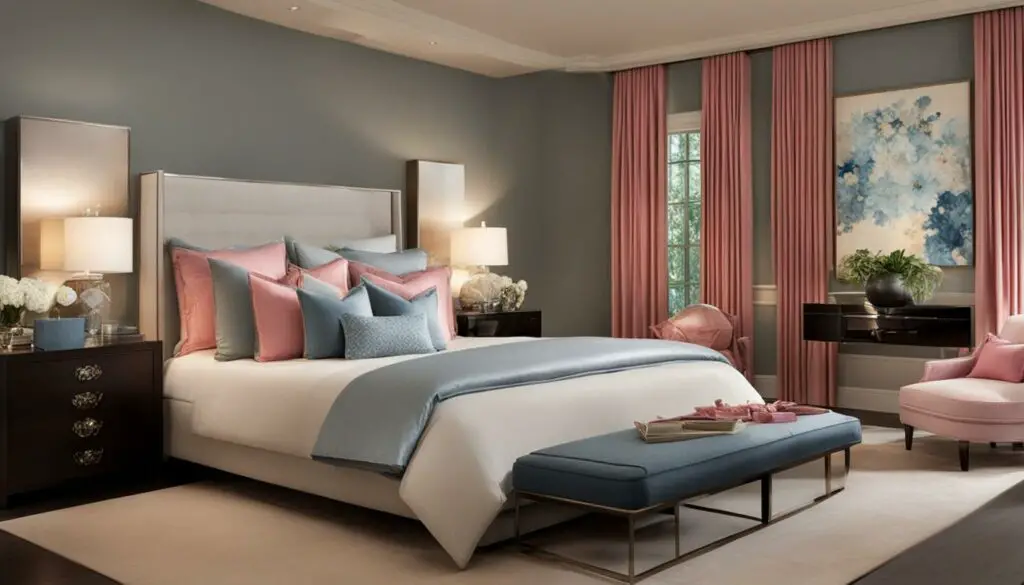
Tips for Using Feng Shui Bedroom Colors for Love and Romance:
- Use red or pink accents such as throw pillows, curtains, or a rug to add a romantic touch to your bedroom.
- Consider adding candles or soft lighting to create a warm, intimate atmosphere.
- Use white bedding or curtains to promote a sense of purity and innocence.
- Incorporate purple accents, such as a vase or artwork, to add a luxurious and sensual feel to your space.
- Remember to keep the overall balance of color in mind and choose colors that make you feel happy and comfortable.
Bedroom Color Combinations for Positive Energy
Creating a harmonious and positive energy flow in your bedroom can be achieved by using the right color combinations. The color choices you make can impact the overall vibe of the room.
One color combination that is often recommended for promoting positive energy is green and blue. Green is associated with nature and growth, while blue is calming and refreshing. Together, they create a peaceful and balanced atmosphere in your bedroom. Consider adding green plants and blue decor accents, such as throw pillows or curtains, to your bedroom.
| Color Combination | Effect on Mood |
|---|---|
| Yellow and gray | Creates a warm and cozy feeling |
| Purple and white | Creates a serene and calming atmosphere |
| Pink and gray | Creates a soothing and romantic ambiance |
Another option is to use warm colors, such as yellow and orange, which can create a cheerful and inviting mood. These colors are associated with happiness and positivity and can be incorporated through bedding, artwork, or accent walls.

When designing your bedroom color scheme, it’s important to choose colors that make you feel calm and relaxed. Whether it’s a blue accent wall or a yellow duvet cover, find colors that speak to you and create a positive energy flow in your sleep sanctuary.
Bedroom Color Schemes for Relaxation
When it comes to creating a relaxing bedroom, choosing the right color scheme is crucial. Colors can have a significant impact on our mood and emotions, so it’s essential to select hues that promote relaxation and calmness. Here are some bedroom color schemes recommended for a restful and rejuvenating sleep experience:
| Color | Description |
|---|---|
| Blue | Blue is a popular choice for bedrooms as it’s known for its calming and soothing properties. Lighter shades of blue create a peaceful environment, while deeper shades evoke a sense of tranquility. |
| Lavender | Lavender has been shown to reduce stress and anxiety, making it an ideal color for the bedroom. It’s also believed to promote restful sleep, making it a popular choice for those with insomnia. |
| Green | Green is a calming color that is associated with nature and the outdoors. Lighter shades of green are ideal for promoting relaxation, while deeper shades can create a sense of security and stability. |
| Gray | Gray is a neutral color that can create a serene and calming environment in the bedroom. It’s also a versatile color that pairs well with a variety of other hues, making it an ideal choice for a minimalist design. |
When selecting colors for your bedroom, consider combining shades to create a harmonious color scheme. For example, pairing lavender with soft shades of blue or green can create a calming and soothing atmosphere. Additionally, avoid bright or bold colors that can be overstimulating and disruptive to a restful sleep environment.
Avoiding Sleep Disrupting Colors
While certain colors are recommended for creating a relaxing sleep environment, others should be avoided. Here are some colors that can be sleep-disrupting:
- Red: Red is a bold and stimulating color that can evoke feelings of passion and excitement. However, it’s also associated with danger and can be unsettling, making it a poor choice for the bedroom.
- Yellow: While yellow can be a cheerful and uplifting color, it can also be overstimulating and disruptive to a restful sleep environment. Bright shades of yellow should be avoided in the bedroom.
- Orange: Orange is a warm and energetic color that can be stimulating and disruptive to sleep. It’s best to avoid using it in the bedroom.
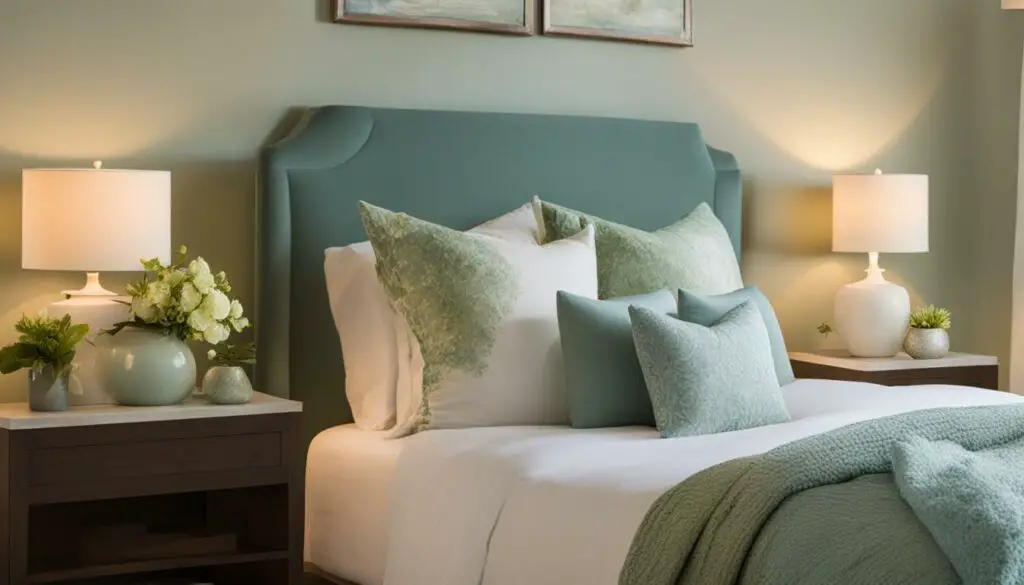
In conclusion, selecting the right color scheme for your bedroom can significantly impact your sleep quality and overall well-being. When choosing colors, consider the calming properties of shades like blue, lavender, green, and gray, and avoid overstimulating colors like red, yellow, and orange. With the right color scheme, you can create a tranquil and soothing sleep environment that promotes restful sleep and rejuvenation.
Feng Shui Bedroom Decorating Tips
If you’re looking to create a peaceful and restful sleep sanctuary, incorporating Feng Shui principles into your bedroom decor can help. Here are some tips for decorating your bedroom according to Feng Shui:
- Choose your colors wisely: As we’ve discussed in previous sections, color plays a crucial role in creating a peaceful atmosphere. Stick to calming and soothing colors, such as blue, green, lavender, and beige. Avoid bold and vibrant colors, as they can be too stimulating for relaxation.
- Declutter your space: A cluttered and messy bedroom can disrupt the flow of energy, making it difficult to relax and unwind. Keep your bedroom clean and organized, and try to minimize the number of items in your space.
- Position your bed properly: According to Feng Shui principles, your bed should be placed in a commanding position, where you can see the door but are not directly in line with it. This promotes a sense of safety and security, allowing you to fully relax.
- Create a balance of elements: Feng Shui emphasizes the balance of the five elements: wood, fire, earth, metal, and water. Incorporate these elements into your bedroom decor by adding plants, candles, crystals, metal accents, and a small fountain or bowl of water.
By following these simple Feng Shui bedroom decorating tips, you can create a peaceful and harmonious sleep sanctuary that promotes restful sleep and overall well-being.
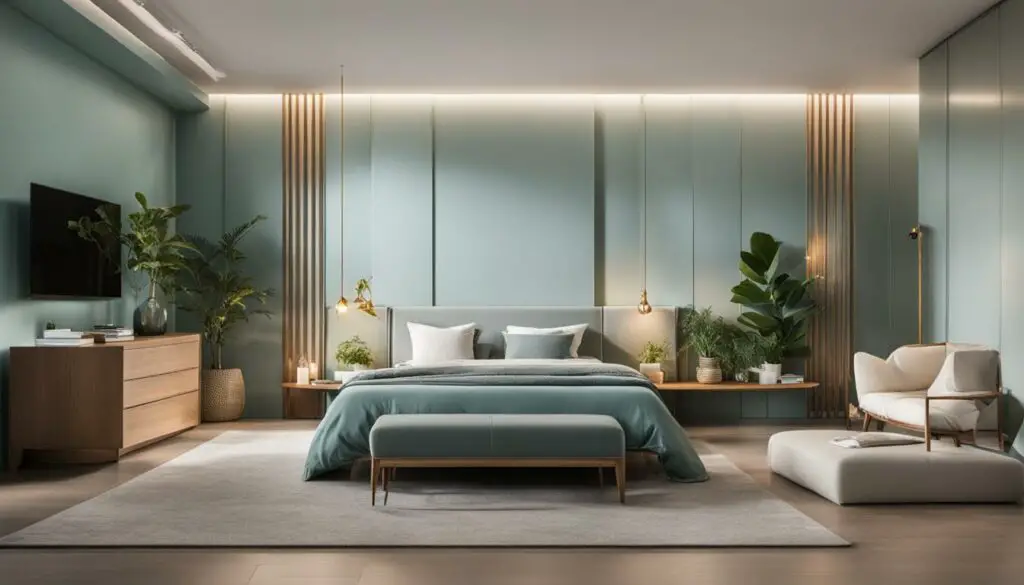
Creating a Harmonious Sleep Sanctuary
Now that you have a good understanding of the power of color in the bedroom, it’s time to put it into practice and create your own harmonious sleep sanctuary.
Start by choosing a color scheme that aligns with your personal preferences and the principles of Feng Shui. Consider the mood you want to create in your bedroom and select colors that evoke that feeling.
Remember that the color of your walls is just one aspect of creating a relaxing environment. Pay attention to the colors and patterns of your bedding, curtains, and decor items to ensure they all work together to create a cohesive look.
When arranging furniture, be mindful of the principles of Feng Shui and aim to create a layout that promotes positive energy flow. Avoid placing your bed directly opposite the door, and position it so that you have a clear view of the entrance but aren’t in direct line with it.
Lighting is also important in creating a peaceful atmosphere. Use soft, warm lighting to create a relaxing ambiance, and avoid harsh overhead lights that can be jarring to the senses. Layer your lighting with different sources, such as bedside lamps and dimmer switches, to create a variety of lighting options for different times of day and activities.
Finally, don’t forget to declutter and remove any items that create a sense of chaos or stress. Keep your sleep sanctuary tidy and organized to promote a calming environment that is conducive to rest.
Example of a Color Scheme for a Harmonious Sleep Sanctuary:
| Color | Significance |
|---|---|
| Light Blue | Creates a sense of calm and tranquility |
| Soft Green | Evokes feelings of renewal and balance |
| Lavender | Promotes relaxation and peacefulness |
| White | Represents purity and clarity |
By incorporating these colors into your sleep sanctuary, you can create a calming and nurturing environment that promotes restful sleep and rejuvenation.
Remember, the key to creating a harmonious sleep sanctuary is to combine your personal preferences with the principles of Feng Shui. Experiment with different colors and decor choices to find what works best for you, and enjoy the benefits of a peaceful and rejuvenating sleep experience.

Conclusion
Choosing the right colors for your bedroom can have a significant impact on your sleep quality and overall well-being. By incorporating Feng Shui principles into your bedroom decor, you can create a peaceful and nurturing sleep environment that promotes restful sleep and rejuvenation.
Remember to pay attention to the color schemes and psychology behind each hue. Select colors that promote calmness, relaxation, and positivity. Consider creating a calming bedroom color palette with a combination of complementary shades to promote a balanced and harmonious atmosphere.
Tips for Creating a Harmonious Sleep Sanctuary
Here are some tips to help you create a harmonious sleep sanctuary:
- Choose calming colors for your walls and decor
- Position your bed in a way that allows you to see the door while lying down
- Eliminate clutter and keep your bedroom clean and organized
- Use soft ambient lighting to create a relaxing atmosphere
- Avoid placing technology devices in your bedroom
By following these tips and incorporating Feng Shui principles into your bedroom design, you can create a restful and rejuvenating sleep sanctuary that will leave you refreshed and energized every morning.
FAQ
How can choosing the right colors for my bedroom enhance my sleep quality?
The colors in your bedroom can create a peaceful and soothing environment, promoting relaxation and better sleep.
What are the different color schemes recommended by Feng Shui for the bedroom?
Feng Shui experts suggest various color schemes, such as neutral tones, cool blues, and earthy greens, to create balance and harmony in the bedroom.
Which are the best Feng Shui colors for bedrooms?
Some of the top Feng Shui colors for bedrooms include soft blues, gentle greens, calming grays, and warm neutrals like beige and taupe.
How does color psychology play a role in bedroom design?
Different colors have psychological effects on mood and sleep patterns. Understanding color psychology can help you choose hues that create a desired atmosphere in your bedroom.
What paint colors are known for creating a peaceful bedroom?
Paint colors like light blues, soft grays, and pale lavender are popular choices for creating a tranquil and serene ambiance in the bedroom.
What are some calming colors to consider for my bedroom?
Colors like sage green, lavender, pale pink, and light gray are known for their calming properties and ability to reduce stress and anxiety.
Can Feng Shui bedroom colors enhance love and romance?
According to Feng Shui principles, colors like soft pinks, romantic reds, and warm neutrals can create an energetic environment that fosters intimacy and harmonious relationships.
How can I create a bedroom with positive energy using color combinations?
Combining complementary colors like blue and orange, or green and pink, can create a balanced and harmonious energy flow in your bedroom.
Which color schemes are best for promoting relaxation in the bedroom?
Color schemes with soft pastels, earth tones, and muted shades can help create a soothing and calming atmosphere, perfect for promoting relaxation and restful sleep.
What are some Feng Shui bedroom decorating tips?
Feng Shui bedroom decorating tips include arranging furniture to promote energy flow, incorporating natural elements, and using soft lighting to create a peaceful ambiance.
How can I create a harmonious sleep sanctuary using Feng Shui principles?
By combining the knowledge of bedroom color ideas, Feng Shui color schemes, and decor tips, you can create a harmonious sleep sanctuary that promotes restful and rejuvenating sleep.
